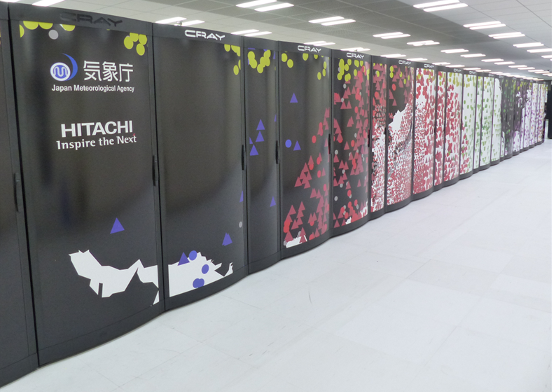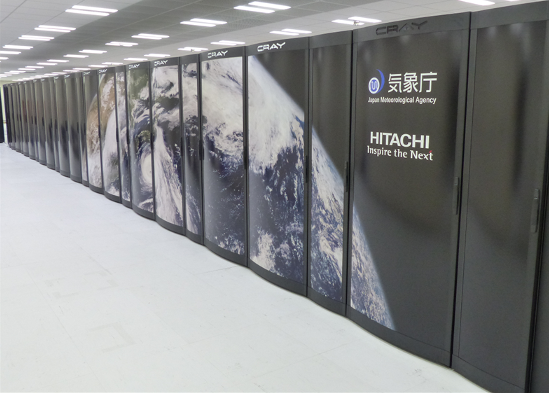 |
 |
 |
 |
The Japan Meteorological Agency (JMA) began the operation of its new supercomputer system on 5 June 2018. The system has 10 times more capacity in terms of meteorological numerical calculation than its predecessor, and can also process larger amounts of data at higher speeds.
JMA leverages its supercomputer for a variety of numerical calculations in monitoring and prediction of weather and climate conditions over periods ranging from the short term to several months ahead, and utilizes the results to support the output of meteorological information for use in disaster prevention, daily life, socio-economic activity and a variety of other areas.
The Agency plans to utilize the new supercomputer for precise early prediction of typhoons and localized torrential rain and for improvements in various types of information, including sequential prediction on scales ranging from weeks to months.
The main planned improvements to prediction information are outlined below. The schedule shown is for domestic service upgrades. Related international services will be upgraded accordingly.
The forecast range for 00, 06, 18 UTC initials of JMA's global spectral model (GSM) will be extended from the current 84 hours (3.5 days) to 132 hours (5.5 days) (scheduled implementation by late June 2018). JMA plans to extend the forecast period from the current 3 days ahead to 5 days ahead for typhoon intensity (central pressure, maximum wind speed, etc.; scheduled implementation by late March 2019).
The scope of JMA's short-range precipitation forecasts, which predict detailed precipitation distribution, will be extended from the current 6 hours ahead to 15 hours ahead (scheduled for implementation by late June 2018). The launch of a new meso-scale ensemble prediction system for disaster-generating meteorological phenomena such as torrential rains and wind storms is also planned (scheduled implementation in 2019).
JMA plans to issue fortnight forecasts on five day-average temperatures once a day from mid-2019 onward, and remains committed to improving sub-seasonal/seasonal forecasts via upgrades to infrastructure such as its Global and Seasonal Ensemble Prediction Systems.
JMA plans to upgrade its Aeolian dust prediction system using observational data from the Himawari-8 geostationary meteorological satellite to provide a new chart product representing the results of seamless daily analysis and prediction of Aeolian dust distribution (scheduled in fiscal year 2019).
| Previous | New | |
|---|---|---|
| Model | HITACHI SR16000/M1 (Vendor: Hitachi) |
Cray XC50 (Vendor: Hitachi) |
| Theoretical Peak Performance | 847 TFlops (*) | 18,166 TFlops |
| Capacity of Main Memory | 108 TBytes | 528 TBytes |
| Capacity of Magnetic Disk | 348 TBytes | 10,608 TBytes |
* TFlops: capability to perform a trillion floating-point calculations per second